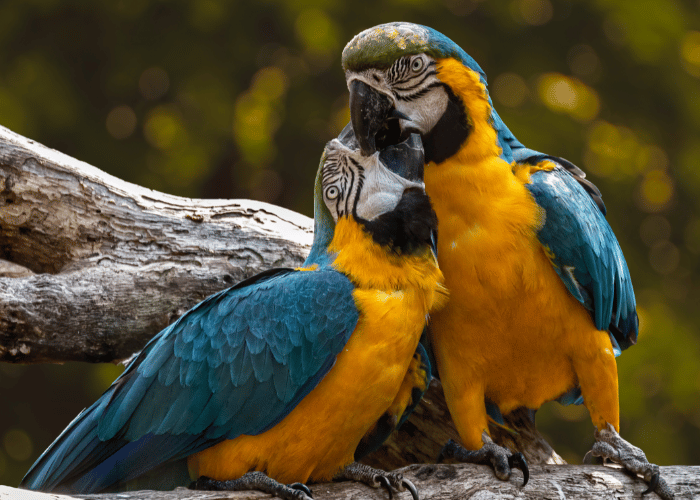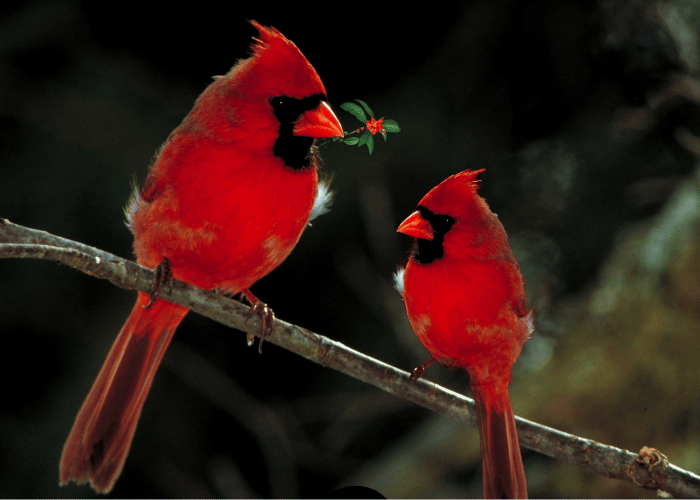Are Birds Warm Blooded
Table of Contents
Have you ever wondered about the biological intricacies of birds? Birds, in fact, are warm-blooded creatures. This adaptation is paramount for their survival in a variety of environments. Being warm-blooded, or endothermic, allows birds to maintain a constant body temperature, regardless of the external atmospheric conditions. This unique attribute facilitates their high metabolic rates, mobility, and overall survival.
Your curiosity doesn’t end here, does it? Well, there’s much more to explore about our feathered friends’ physiology. Their ability to self-regulate body temperature derives from their efficient metabolic processes and special physical characteristics, like feather insulation. Other factors that contribute include the bird’s size and distinctive behaviors such as migration and communal roosting.
This incredible biological marvel doesn’t just stop at being an interesting trivia tidbit. It holds critical lessons about survival adaptability, energy efficiency, and much more. So, as you delve deeper into understanding ‘why are birds warm-blooded?’, be prepared to explore their fascinating world from an elevated perspective. And remember, the more you learn, the more you’ll realize that there’s always something new to discover in the intricate world of biology.

Understanding Bird Physiology
When you observe birds fluttering above, it’s easy to overlook the complexity of their physiology. Among the numerous questions surrounding their structure and characteristics, the question of whether or not birds are warm-blooded draws particular interest. This inquisitiveness perhaps stems from an urge to understand the creatures that share our world.
In simplest terms, birds are, indeed, warm-blooded. Also known as being endothermic, this trait allows birds to maintain their body temperature regardless of the surrounding environment. So, whether they’re in the chilly heights of the Himalayas or the scalding sands of the Sahara, birds can keep their bodies at a constant temperature, which is essential for their survival.
Many people often wonder how birds manage to stay warm, especially during the harshest of weathers. Unlike humans who need external sources of warmth, birds have an intricate system of heat regulation. They generate heat internally, primarily through their metabolism. Your understanding will deepen with the realization that their unusually high metabolic rate allows their bodies to produce and retain a lot of heat.
Compare the average body temperature of a bird to that of a human, and you’ll find that a bird’s body temperature is significantly higher. Most bird species maintain a body temperature ranging from 40°C to 44°C (104°F – 111.2°F).
| Human | Bird | |
|---|---|---|
| Average body temperature | 37°C (98.6°F) | 40-44°C (104-111.2°F) |
Such high body temperatures aid in their high energy lifestyle, propelling them to fly and be active for long periods of time.
Even in their resting state, birds consequently consume more energy than their cold-blooded counterparts. You’ll find it fascinating that the energy birds use while sleeping or resting is what reptiles might use to stay active!
- Birds are warm-blooded, or endothermic
- They maintain a consistent body temperature regardless of their environment
- Their high metabolic rate aids in producing and retaining body heat
- Most birds have a body temperature ranging from 40-44°C (104-111.2°F)
- High body temperature lands them a high-energy lifestyle.
This glimpse into bird physiology should offer you a foundation for appreciating the incredible ways in which birds are adapted to live alongside us. After all, understanding the natural world begins with understanding its inhabitants.
Are Birds Warm Blooded? The Science Behind It
If you’ve ever wondered, “Are birds warm blooded?” then you’re not alone. It’s a question that’s sparked curiosity in many minds. So let’s uncover the science behind this intriguing facet of avian biology.
To begin, the answer is yes, birds are indeed warm-blooded, which in scientific parlance also means they are endothermic. Endotherms can regulate their body temperature by producing heat internally, a trait that differentiates them from cold-blooded or ectothermic organisms (like reptiles), that rely heavily on external heat sources. It’s the ability of birds to maintain a constant body temperature which allows them to inhabit a wide range of environments.
Here’s a comparison of body temperatures of some hot-blooded and cold-blooded animals:
| Animal | Average Body Temperature (°F) |
|---|---|
| Human | 98.6 |
| Bird | 105 |
| Reptile | 80 – 90 |
This ability to self-regulate temperature stems from a spectacular array of adaptations. Notably, birds possess an efficient respiratory system, featuring air sacs that help to dissipilate heat. Insulative feathers also play a huge part in retaining body warmth.
Moreover, you’ll find that these feather-covered creatures vary their metabolic rates to adapt to fluctuating environmental conditions. A metabolic conversion called thermogenesis enables them to generate heat and maintain their high body temperatures.
To summarise:
- Birds are warm-blooded, or endothermic.
- They maintain a constat body temperature, around 105°F on average.
- Key adaptations include efficient respiratory system, insulative feathers, and variable metabolic rates.
So next time you observe a flock of birds effortlessly soaring amidst snowy landscapes, or dwelling in arid deserts, remember, it’s their warm-blooded nature that makes it possible. In this light, avian adaptation appears even more remarkable, doesn’t it?

Avian Thermoregulation: A Detailed Overview
Thermoregulation is the process by which birds, like all warm-blooded animals, maintain their body temperature within certain boundaries. You’ll find it’s a fascinating blend of physiology and behavior that ensures birds thrive in diverse climates.
Birds’ bodies generate heat during digestion and muscle activity. Surprisingly, certain frigid conditions can complicate heat retention. Luckily, birds possess multiple strategies to conserve heat. These include:
- Fluffing up their feathers to trap air, which serves as a thermal insulation.
- Tucking their beaks into their shoulder feathers when resting, reducing heat loss from a potentially exposed area.
- Counter-current heat exchange, a sophisticated system where warm arterial blood transfers heat to colder venous blood returning from the extremities. This mechanism allows birds to maintain a relatively high core body temperature.
Birds also have ways to handle excess heat during hot conditions. They can increase blood flow to their skin surface or wings, dissipating excess heat to the environment. Furthermore, some species will pant or flutter their throat muscles—actions that increase evaporation and lower body temperature.
Table 1 summarizes these thermoregulatory mechanisms.
| Mode | Action | Purpose |
|---|---|---|
| Heat Conservation | Fluffing feathers, beak tucking, counter-current heat exchange | To maintain high body temperature in cold condition |
| Heat Dissipation | Increasing surface blood flow, panting, throat muscle fluttering | To lower body temperature during hot conditions |
Lastly, migration plays its part in thermoregulation too. Many bird species migrate to warmer or colder regions during certain seasons for a more comfortable climate. This is yet another testament to nature’s remarkable design to ensure survival.
The system of avian thermoregulation serves as a compelling demonstration of biology’s innovations. Not only do these mechanisms allow birds to survive extreme temperatures, but they also support the high metabolic demands of flying. Understanding these adaptations could provide you with a whole new appreciation for our feathered friends. So next time you see a bird fluffing up its feathers during winter, you’ll know it’s more than just a charming jesture—it’s science in action.
Comparing Birds to Other Warm-Blooded Animals
It’s typical to lump birds in with mammals as warm-blooded animals, but there’s certainly more to it than that. While it’s true, both birds and mammals have the ability to regulate their body temperatures, the ways in which they accomplish this differ significantly.
Consider the metabolic rates of different animals. Birds, you’ll find, generally have faster metabolic rates than their mammalian counterparts. In fact, birds have to consume more food, relative to their weight, to keep up with their caloric demands. That’s because flying is an extremely energy-intensive activity that requires a high metabolism. Additionally, birds often need to maintain a higher internal body temperature than mammals to allow for efficient muscle contractions during flight. To better comprehend this, here’s a basic chart comparing the average body temperature of different animals:
| Animal Type | Average Body Temperature (F) |
|---|---|
| Birds | 105 |
| Mammals | 98.6 |
| Reptiles | 70-85 (variable) |
Understand, too, the differences in the manner of temperature regulation. Birds tend to use more physical methods of temperature regulation, such as fluffing up their feathers or seeking shade. It’s in stark contrast to many mammals which primarily rely on internal physiological mechanisms like sweating or panting to dissipate heat.
Plus, there’s a difference in heat distribution as well. You might find this surprising, birds can keep their feet cool while the rest of their body stays warm. Impressive, isn’t it? Their circulatory system allows them to reduce heat loss by adjusting blood flow to their extremities. Mammals, on the other hand, don’t have such precise control over their heat distribution.
In summary, while birds and mammals are both warm-blooded, they regulate and distribute their body temperature in very unique ways. This knowledge can help you appreciate the extraordinary adaptations that allow these creatures to thrive in their specific environments. Who knew being warm-blooded could be so complex, right?
How Bird Thermoregulation Affects their Behavior
Thermoregulation is critical in a bird’s daily life. Birds, like mammals, are categorized as endothermic or “warm-blooded”, which means they maintain a constant internal body temperature regardless of their surroundings. Yet, it’s important to understand how this ability to regulate body temperature influences a bird’s behavior.
Birds use several strategies to maintain their body temperature. In the colder months, they fluff up their feathers and in the warmer months, they hold their wings away from their bodies to release heat. These behavioral adjustments are indicative of a bird’s thermoregulatory capabilities.
Keeping constant body temperature requires energy. Birds, particularly in colder environments, consume more food, thereby increasing their metabolic rate because a higher food intake supplies the energy necessary to keep their bodies warm. So if you’re observing an uptick in your backyard bird activity during winter, it’s likely due to their increased need for food. We emphasize again, body temperature regulation requires energy expenditure, hence more nourishment is needed.
To further illustrate this, take a look at the following table:
| Temperature (°F) | Per-day Food Intake for small bird (grams) |
|---|---|
| 37 | 4.5 |
| 15 | 6.5 |
| 0 | 10 |
You could consider the following main points:
- Birds are endothermic or warm-blooded, which means they maintain a constant body temperature.
- The environment affects a bird’s behavior to thermoregulate, such as ruffling feathers in cold.
- Increased energy expenditure in colder temperatures necessitates more food intake.
In essence, although birds maintain a constant internal body temperature, their behaviors are still considerably influenced by external environmental conditions. Their survival literally depends upon it, hence their behaviors adjust accordingly. In other words, the action of the little bird on your window sill, whether it’s fluffing its feathers or pecking more frequently at your bird feeder, can tell you a lot about what’s happening inside its little body and mind.
A broader understanding of bird thermoregulation certainly adds a fascinating dimension to your casual bird-watching! Understanding this mechanism not only bridges your connection with these feathered creatures but also deepens your appreciation for the astounding intricacies of nature.

Conclusion: Unique Characteristics of Birds’ Temperature Regulation
Your journey of understanding birds and their bodily regulations brings you here. And you’ve quickly realized that birds have a remarkable way of controlling their body temperature. They are indeed warm-blooded creatures and belong to a group known as endotherms. This fact alone illuminates their fascinating ability to maintain a constant body temperature regardless of the environmental conditions, in sharp contrast to cold-blooded animals.
Just like humans, birds have a body temperature that hovers around the 40°C mark (104°F). This high temperature aids in fueling the high-energy lifestyle of these aerial acrobats. To unravel how these creatures manage to regulate their body temperature, let’s take a quick review:
- Feathers: Birds utilize their feathers for more than just flight. Feather fluffing, for instance, is a common technique birds deploy to create insulating air pockets, helping trap heat close to their body.
- Shivering Thermogenesis: When it’s extremely cold, birds shiver intentionally in order to generate heat. Specifically, they shiver in such a way that muscle contractions produce warmth instead of movement.
- Torus: Birds have a unique physical structure known as a ‘torus’, a specialized region of blood vessels located at the top of their legs. With this, they can precisely control the flow of warm blood into their feet, mitigating the risk of rapid heat loss.
Knowing these unique characteristics gives you a new perspective on these fascinating feathered friends of ours. So, every time you catch sight of a bird braving the winter chill or fluttering about in the summer heat, you’ll be able to appreciate the wonder of their finely-tuned internal thermostats.
Birds’ uncanny ability to regulate their body temperature is just one of the numerous adaptations they’ve made to conquer the skies. But remember, it’s up to us to protect their habitats and ensure these wonderful creatures continue to soar and sing for generations to come.






